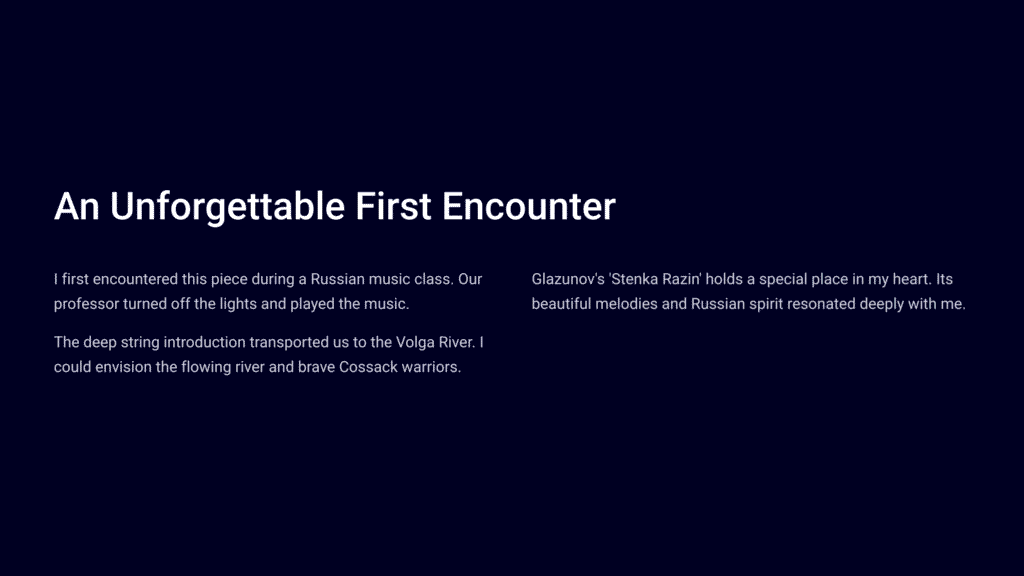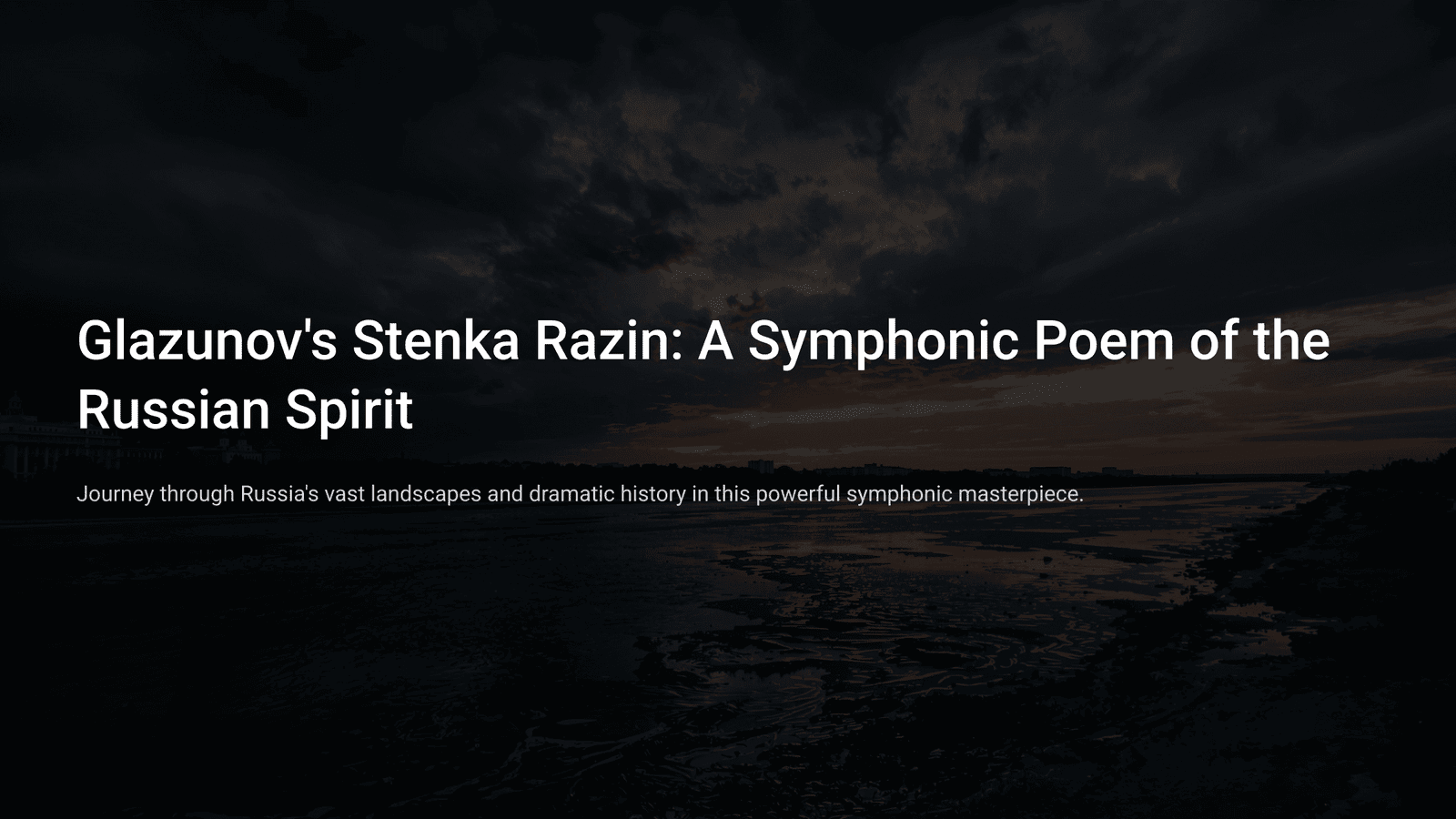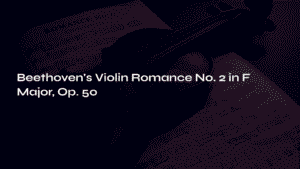Table of Contents

An Unforgettable First Encounter
I first encountered this piece during a Russian music class in college. Our professor turned off the lights and played the music. As the deep, dark string introduction began to flow, the room seemed to transport instantly to the vast banks of Russia’s Volga River. Closing my eyes, I could envision the powerful flowing river and the brave Cossack warriors.
Since that day, Glazunov’s ‘Stenka Razin’ has held a special place in my heart. Not simply because of its beautiful melodies, but because the story it tells and the Russian spirit embedded within it resonated deeply with me.

A Young Genius’s Masterwork
Alexander Glazunov (1865-1936) composed ‘Stenka Razin (Op. 13)’ in 1885, when he was merely twenty years old. This symphonic poem was dedicated to Alexander Borodin, his mentor and source of inspiration, and stands as one of the few works dealing with Russian nationalist themes among Glazunov’s extensive catalog.
This period was a time when Russian composers were actively incorporating folk melodies and historical narratives into their music in search of national identity. First performed on November 23, 1885, in St. Petersburg under the direction of G.O. Dutsch, the work received financial support from Mitrofan Belyayev, an important patron of Russian music at the time. ‘Stenka Razin’ proved to be a true breakthrough for young Glazunov, establishing him as a significant voice in Russian orchestral music.

Stenka Razin: A Hero of the Russian People
The protagonist of this piece is Stepan (nicknamed “Stenka”) Razin, a Don Cossack leader who led a major peasant uprising against Tsar Alexis of the Romanov dynasty in the 17th century. Operating from a stronghold near the Volga River, Razin posed a serious threat to the Tsarist regime.
According to historical records, Razin was initially captured but granted amnesty on the condition that he pledge allegiance to the Tsar. However, he broke this oath and subsequently led an army reportedly numbering several hundred thousand in an attempt to overthrow the government. After his second capture, Razin was publicly executed in 1671. His rebellion eventually became enshrined in Russian folk legend, providing rich material for artistic interpretation.

A Narrative Painted in Music
‘Stenka Razin’ follows the typical programmatic structure of 19th-century symphonic poems, with music that directly illustrates the dramatic narrative.
Form and Themes
The composition is written in B minor and typically lasts about 15-18 minutes. The work opens with a mysterious slow introduction that establishes the setting of the Volga River through ominous low strings. This introduction directly quotes “The Song of the Volga Boatmen,” utilizing its distinctive four-note motif as a representation of Russian folk identity.
The main section (Allegro con brio) remains in B minor and depicts Razin’s raids along the Volga River. The central portion of the work (Allegro moderato) provides contrast through a sensual, undulating clarinet melody written in a major key a semitone lower. This theme reportedly represents the Persian princess character and has been claimed to be of Persian origin, though filtered through a Russian compositional lens.
Orchestration
Glazunov demonstrates remarkable orchestration skills in this early work, employing a full Romantic orchestra with:
- 3 flutes (3rd also playing piccolo)
- 2 oboes
- 2 clarinets
- 2 bassoons
- 4 horns
- 2 trumpets
- 3 trombones
- Tuba
- Timpani
- Percussion (cymbals, bass drum, tam-tam)
- Harp
- Strings
This orchestration reflects Glazunov’s study of Borodin and Tchaikovsky’s techniques, with colorful instrumental combinations that effectively portray both the sweeping Russian landscapes and the dramatic emotional content of the story.

The Story Within the Music
This symphonic poem focuses on a particularly dramatic moment in the Stenka Razin legend. As depicted in the music, Razin and his mistress—a captured Persian princess—are traveling on an ornately decorated boat along the River Volga.
According to one version of the story illustrated in the composition, the princess relates an ominous dream warning of imminent disaster and her own death in the river. Suddenly, they are surrounded by tsarist soldiers. In a shocking display of devotion to his cause and the Volga River itself, Razin throws the princess into the water as a sacrifice, declaring: “Never in all my thirty years have I offered a sacrifice to the Volga. Today I will give it what is for me the most precious of all the world’s treasures.” Following this sacrifice, the Cossacks desperately attack the Russian troops.
An alternative version suggests that Razin’s men accused him of becoming less focused on fighting due to his love for the princess—a charge Razin counters by drowning her before leading his followers once again into battle.

My Personal Listening Experience
When I first encountered this piece, I was most impressed by its powerful contrasts. From the majestic introduction depicting the slow flow of the Volga River to the fierce battle of the Cossack warriors, and the lyrical melody expressing the Persian princess—the way all these elements connect organically within a single narrative is truly moving.
Particularly beautiful is the clarinet melody that plays the princess’s theme. This oriental melody encountered amid the intensity of Russian music sometimes feels like a meeting of two disparate cultures. And the way the melody disappears in the scene where she falls into the water is truly poetic.
It’s also astonishing that Glazunov composed such a complex work at just twenty years of age. I often find myself laughing as I wonder, “What was I doing at that age?” His genius shines through every measure of this work.

Ways to Enjoy the Music More Deeply
Would you like to appreciate ‘Stenka Razin’ more richly? Here are a few suggestions:
- Listen while imagining the Volga River: Envisioning the vast Russian landscape will make the music’s grandeur feel even more vivid.
- First identify the main themes: Try to distinguish the Volga River theme (introduction), Stenka Razin’s theme (intense B minor melody), and the Persian princess’s theme (lyrical clarinet melody).
- Listen first to the Russian folk song “The Song of the Volga Boatmen”: Knowing this folk song that Glazunov quoted will help you understand the work’s national roots more deeply.
- Compare interpretations by different conductors: In particular, the performances by Evgeny Svetlanov and Wilhelm Furtwängler with the Vienna Philharmonic each have their own distinct charm.
- Learn about the historical background of Stenka Razin: Understanding the historical context of the 17th-century Russian peasant uprising will make the revolutionary message of the music even clearer.

A Song of Resistance Transcending Time
‘Stenka Razin’ is more than just a musical work—it is like a historical document capturing the spirit of the Russian people. The story of a figure who stood against power from a position of weakness inspires us across time. During the Russian revolutions of 1905 and 1917, the story of Stenka Razin was once again used as a rallying cry for the people.
Through this work, Glazunov excellently carried on the tradition of Russian nationalist music. While clearly showing the influence of his teacher Borodin and “The Mighty Five” (Balakirev, Cui, Mussorgsky, Rimsky-Korsakov, and Borodin), he also presents his own unique voice as a young composer.
Even 140 years after its premiere, this work still holds an important place in the orchestral repertoire. Through the interpretations of outstanding conductors such as Neeme Järvi, Evgeny Svetlanov, and Konstantin Krimets, the vitality of this piece continues.
Music sometimes conveys the past more vividly than history books. Glazunov’s ‘Stenka Razin’ serves as a medium for time travel that directly transmits the spirit of the 17th-century Russian peasant uprising to us today. Each time I listen to this piece, I feel humanity’s eternal yearning for freedom and justice.
I hope you too will journey through Russia’s vast landscapes and dramatic history through this piece. Surrendering to the waves of music and following the flow of the Volga River, perhaps you may encounter the indomitable spirit of Stenka Razin.
#RussianMusic #Glazunov #StenkaRazin #SymphonicPoem #ClassicalMusic #VolgaRiver #NationalistMusic



